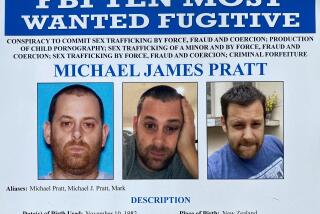‘Most Wanted’ List Turns 50; Members Hardly Celebrating
- Share via
WASHINGTON — There’s David Letterman’s top ten list. There’s the Zagat list of top-notch restaurants and inns. But first there was the FBI’s Ten Most Wanted Fugitive list, which was officially unveiled 50 years ago Tuesday.
The list actually traces its origins to 1949, when a wire service reporter based in Washington asked an FBI agent for the names and descriptions of the “toughest guys” the bureau was pursuing. The cooperative agent arbitrarily provided 10 names, and the subsequent story generated so much attention that FBI Director J. Edgar Hoover--a master at promoting the agency he headed for decades--inaugurated the “top ten” list a year later.
Once dominated by bank robbers, burglars and car thieves, the list has evolved to reflect changing times and crimes. During the politically turbulent 1960s and early 1970s, the list included several fugitives charged with destruction of government property and sabotage. Later in the ‘70s, as the bureau targeted organized crime, those accused of racketeering were prevalent. Today, alleged international terrorists and drug traffickers are prominent.
Currently listed are Osama bin Laden, wanted for murder in the 1998 bombings of U.S. embassies in Tanzania and Kenya; Ramon Arellano Felix, a suspected leader of a Tijuana-based drug cartel; and Agustin Vasquez Mendoza, charged in the killing of a federal Drug Enforcement Administration agent in Arizona.
Also on the list are Eric Robert Rudolph, sought for fatal explosions at an abortion clinic in Birmingham, Ala., and at the 1996 Summer Olympics in Atlanta; and James Charles Kopp, who is suspected of murdering a doctor who performed abortions in the Buffalo area.
The FBI has taken its Top Ten list beyond the local post office. In 1988, “America’s Most Wanted” debuted on television, bringing the stories of some of the country’s most violent criminals--including some from the most wanted list--into millions of homes each week.
The first suspect from the list that the show profiled was caught within three days of the broadcast. Since then, of the 600 or so fugitives that the show’s viewers have helped law enforcement officials apprehend, 12 more have been from the most wanted list.
In 1996, the FBI turned to the Internet, posting the list on the agency’s Web site https://www.fbi.gov. So far, only one arrest has been directly linked to use of the Web site, the capture in 1996 of a fugitive who was traced to Central America.
FBI officials rely on two prime criteria in deciding who to place on the list. Most obviously, fugitives must be considered particularly dangerous. Also, nationwide publicity is seen as key to their arrest.
The first person placed on the list that Hoover released 50 years ago was Thomas James Holden, who was wanted for murdering his wife, her brother and her stepbrother. He was arrested in Beaverton, Ore., 15 months later based on a tip from a citizen who read a story about the fugitives on the list in the Oregonian newspaper.
Occasionally, “special additions” have been made to the list, causing it to exceed 10. The all-time high occurred in 1970, when 16 fugitives were judged “most wanted.”
Of the 458 fugitives who have appeared on the list, 429 have been apprehended or located, FBI officials say. Also:
* Only seven women have been on the list. The first, Ruth Eisemann-Schier, was added in 1968 for kidnapping and extortion.
* More of the list’s fugitives--57--have been found in California than anywhere else. Arrests have been made in every state except Alaska, Delaware and Maine.
* Two fugitives were caught after visitors of an FBI tour recognized their photographs on display.
* Donald Eugene Webb, who remains wanted for the murder of a Pennsylvanian police chief, has spent the longest amount of time on the list--more than 18 years.
* Billie Austin Bryant spent the shortest amount of time in the top ten. He was captured two hours after he was listed in 1969.
More to Read
Sign up for Essential California
The most important California stories and recommendations in your inbox every morning.
You may occasionally receive promotional content from the Los Angeles Times.













